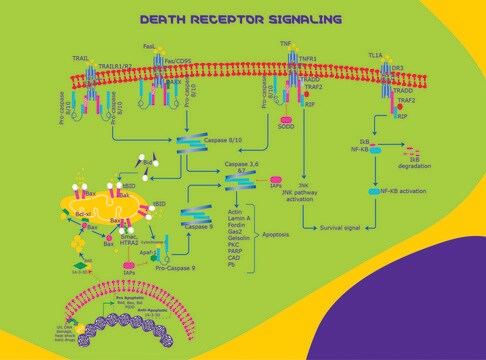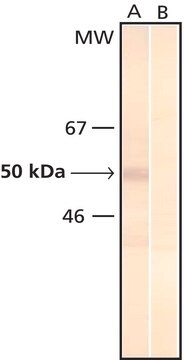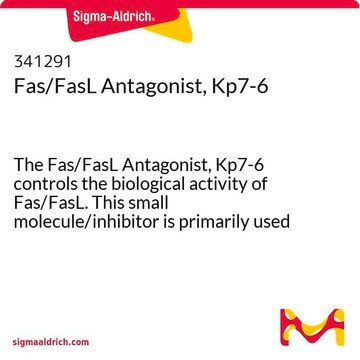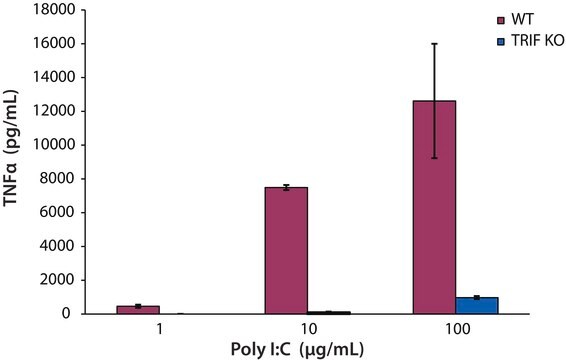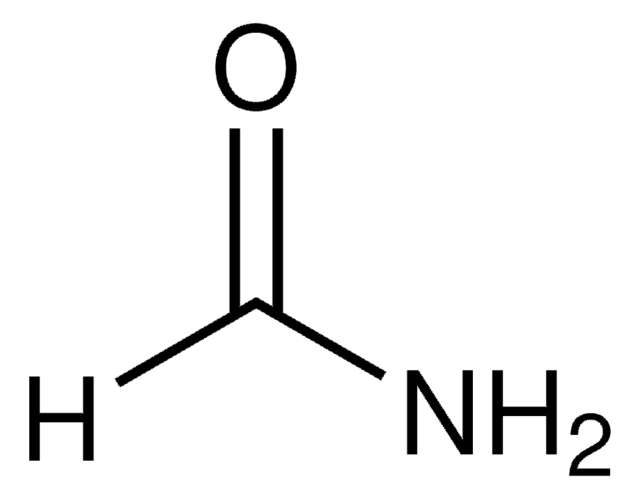추천 제품
재조합
expressed in CHO cells
Quality Level
분석
>95% (SDS-PAGE)
양식
lyophilized powder
분자량
monomer calculated mol wt ~18 kDa
26-28 kDa by SDS-PAGE
불순물
endotoxin, tested
UniProt 수납 번호
저장 온도
−20°C
유전자 정보
human ... FASLG(356)
관련 카테고리
일반 설명
FASLG (Fas ligand) acts as a ligand for Fas receptor, and is a major protein involved in programmed cell death, apoptosis. Soluble Fas (sFAS) is usually detected in plasma prior to apoptosis.
애플리케이션
Fas Ligand (FASLG) human has been used for-
- the study of FASLG stimulation in luteal cells obtained from mid-corpus luteum (CL) and
- the study of apoptosis induction and intracellular caspase-3 assay in human cells.
생화학적/생리학적 작용
FASLG (Fas ligand) and Fas receptor constitute the basic elements in apoptosis. Interaction of FASLG with Fas receptor leads to activation of caspase-8. This caspase in turn leads to activation of effector caspases such as caspase-3, -6 and -7. This cascade results in the hydrolysis of nuclear and cytoplasmic components. Expression of FASLG is induced by nuclear factor-κB (NFκB). NFκB/FASLG pathway facilitates the suppression of p,p′-DDT (dichlorodiphenoxytrichloroethane)-induced cell toxicity by vitamin C and E. In CD4+ T cells, this protein is expressed on stimulus by T-cell receptor (TCR), both during normal and pathological conditions, such as alcohol exposure.
Fas ligand, a protein belonging to the tumor necrosis factor (TNF) family of cytokines, induces apoptosis in cells expressing the cell membrane receptor Fas (CD95/Apo-1).
Protein belonging to the tumor necrosis factor (TNF) family of cytokines; induces apoptosis in cells expressing the cell membrane receptor Fas (CD95/Apo-1).
기타 정보
Human Fas Ligand, N-terminal 6X histidine-tagged, encodes amino acids 134-281.
물리적 형태
Lyophilized from a 0.2 μm filtered solution in phosphate buffered saline containing 0.5 mg bovine serum albumin.
분석 메모
Measured by its ability to induce apoptosis in Jurkat cells.
신호어
Warning
유해 및 위험 성명서
예방조치 성명서
Hazard Classifications
Eye Irrit. 2 - Skin Irrit. 2
Storage Class Code
11 - Combustible Solids
WGK
WGK 3
Flash Point (°F)
Not applicable
Flash Point (°C)
Not applicable
Malavika S Giri et al.
Journal of immunology (Baltimore, Md. : 1950), 182(7), 4459-4470 (2009-03-21)
Mechanisms that may allow circulating monocytes to persist as CD4 T cells diminish in HIV-1 infection have not been investigated. We have characterized steady-state gene expression signatures in circulating monocytes from HIV-infected subjects and have identified a stable antiapoptosis gene
Xiaoting Jin et al.
PloS one, 9(12), e113257-e113257 (2014-12-03)
Dichlorodiphenoxytrichloroethane (DDT) is a known persistent organic pollutant and liver damage toxicant. However, there has been little emphasis on the mechanism underlying liver damage toxicity of DDT and the relevant effective inhibitors. Hence, the present study was conducted to explore
Aleksander Szymanowski et al.
Atherosclerosis, 233(2), 616-622 (2014-02-19)
Apoptosis of natural killer (NK) cells is increased in patients with coronary artery disease (CAD) and may explain why NK cell levels are altered in these patients. Soluble forms of Fas and Fas ligand (L) are considered as markers of
Antonio M Galvao et al.
Biology of reproduction, 83(6), 901-908 (2010-08-20)
Proapoptotic factor Fas ligand (FASL) and its cell surface receptor FAS are tumor necrosis factor superfamily members that trigger apoptosis in different cell types. However, their influence on luteal steroidogenesis is not clearly understood. The aim of the present work
Intracellular bacteria engage a STING-TBK1-MVB12b pathway to enable paracrine cGAS-STING signalling.
Ramya Nandakumar et al.
Nature microbiology, 4(4), 701-713 (2019-02-26)
The innate immune system is crucial for eventual control of infections, but may also contribute to pathology. Listeria monocytogenes is an intracellular Gram-positive bacteria and a major cause of food-borne disease. However, important knowledge on the interactions between L. monocytogenes
자사의 과학자팀은 생명 과학, 재료 과학, 화학 합성, 크로마토그래피, 분석 및 기타 많은 영역을 포함한 모든 과학 분야에 경험이 있습니다..
고객지원팀으로 연락바랍니다.